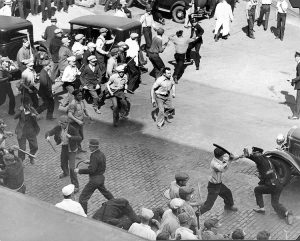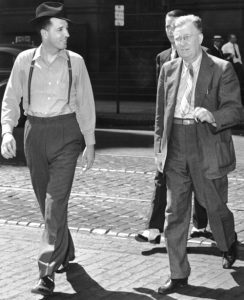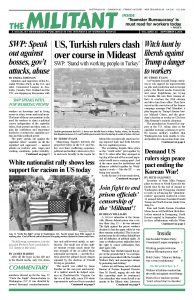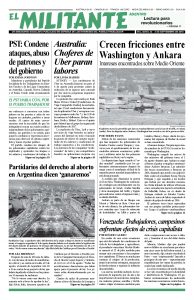Teamster Bureaucracy by Farrell Dobbs, 440 pages, Pathfinder Press, second edition, 2018.

The wealth of lessons in the four-volume Teamsters series by Farrell Dobbs is essential for workers who are beginning to see the need to fight and rebuild the labor movement. In Teamster Rebellion, Teamster Power, Teamster Politics and Teamster Bureaucracy, working people learn firsthand about the most far-reaching and politically significant labor battles of the 1930s.
Above all, they learn about the communist leadership that made these workers’ struggles so powerful and effective — in the words of one of those leaders, Farrell Dobbs. Dobbs was a central organizer of the Teamster battles for more than half a decade.
This year Pathfinder Press has published a new edition of Teamster Bureaucracy, as well as a new translation in Spanish. Now all four volumes, for the first time, are available to workers who read most easily in that language.
The new edition features more than 130 photos and illustrations, most not included in earlier printings. The pictures — as well as headlines, articles and cartoons from both the workers’ press and bosses’ dailies — bring to life the campaigns led by the Minneapolis Teamsters and the rulers’ increasingly repressive response.

The Teamsters leaders worked to organize the unorganized, part of the growing nationwide social movement to organize industrial unions. They reached out to farmers, the unemployed, truckers who owned their own rigs, and other oppressed toilers. They organized politically to mobilize working-class opposition to the imperialist war aims of U.S. capitalism, as the rulers prepared to drag workers into the second world war, which was already spreading across Europe and Asia.
Dobbs, in his 20s, had gotten a job shoveling coal in a Minneapolis truck depot in 1934. Later that year he became a participant and leader of an organizing drive and strikes that broke the back of the open shop in Minneapolis and won union recognition of Local 574 (later 544). When he saw how members of the Communist League (forerunner of the Socialist Workers Party) helped lead this fight, he joined the party.
Dobbs became the central organizer of an 11-state organizing campaign that, by the late 1930s, brought tens of thousands of over-the-road truckers into the union. Through these battles and other political experiences, Dobbs became a central leader of the SWP, serving as the party’s national secretary from 1953 to 1972 and as its candidate for president of the U.S. four times from 1948 to 1960.
The conclusions Dobbs points to in Teamster Bureaucracy are invaluable to workers today who’ve been inspired by and are drawing lessons from working-class battles like the West Virginia and other teachers strikes earlier this year.
When President Franklin Roosevelt won a second term in 1936, he increasingly focused on preparing for the “defense of American interests,” as war clouds loomed over the U.S. rulers’ imperialist rivals worldwide.
‘Trade union campaign against war’
The Minneapolis Teamsters, Dobbs explains, began a campaign in the labor movement to organize opposition to Roosevelt’s war preparations. The first step was to educate the union ranks about the class character of Washington’s wars in the pages of the Northwest Organizer, the Minneapolis Teamsters’ weekly paper. Teamster Bureaucracy reprints editorials and articles that took up the U.S. capitalist rulers’ arguments as they tried to whip up patriotic sentiment for war. The Organizer ran a series by Carlos Hudson on how the bosses used the first imperialist war, which had ended in 1918, to attack the Minnesota labor movement.
Following the December 1937 Japanese bombing of a U.S. gunboat and three Standard Oil tankers, the rulers unleashed a massive wave of anti-Japanese propaganda. “Our” flag had been insulted, and “we” have to respond, the capitalist press howled. The Northwest Organizer replied, “What do they mean by ‘we’ and ‘our’?”
Workers and bosses have counterposed class interests, the Organizer explained. “If the investments of the Standard Oil Company are in jeopardy, that’s Rockefeller’s headache, not ours.”
As the bosses yelled about how “we” had to prepare for war, they were attacking the unions, seeking more profits off our backs.
In the book’s Afterword, Dobbs describes how workers change in the course of labor and social struggles like those the Teamsters engaged in. They “learn to generalize their needs, as a class,” he explains, “and to address their demands on a political basis to the capitalists, as a class.”
“If they are aided in perceiving the essence of an outlived capitalism — they will learn that the existing problems are not incidental,” Dobbs says. “They will then see why governmental control must be taken away from the capitalists by labor.”
And to accomplish that, Dobbs explains, a revolutionary communist party is required.
Teamsters, SWP leaders indicted
The cover of the book’s new edition features the front page of the July 26, 1941, Militant. “Why We Have Been Indicted: Socialist Workers Party Is the Anti-War Party” is the headline. Dobbs describes in detail how the Roosevelt government — in cahoots with the pro-war, pro-Democrat national officials of the Teamsters union — launched a campaign to smash the militant Midwest Teamsters movement and imprison its leaders.
The book shows how the U.S. rulers organized to reinforce the FBI as what it is today — their anti-labor, anti-communist agency for spying and disruption.
A front-page article from the Minneapolis Morning Tribune is reproduced, detailing the FBI and U.S. Marshal’s raid on the Socialist Workers Party headquarters there June 27, 1941. It is accompanied by images of newspaper headlines reporting the July 15 federal indictment of 29 leaders of the SWP and Local 544 on “sedition” charges of seeking to overthrow the government.
Dobbs describes the far-reaching public campaign the party and unionists organized, winning broad support from the labor movement, the American Civil Liberties Union, the NAACP and other organizations for the “constitutional right to carry on political work, including opposition to imperialist war.” Mass meetings were held to protest the frame-up trial.
In the chapter titled “If That Is Treason…” Dobbs details the testimony of the first witness for the defense — SWP National Secretary James P. Cannon, who outlines what the SWP stands for.
In what the Minneapolis Tribune called a “scene like a classroom,” Cannon explained the workings of the capitalist system — how it is based on the exploitation of workers; is wracked by periodic crises, like the deep depression that opened in 1929; how its workings sharpen competition between capitalists at home and abroad, which inevitably leads to imperialist wars.
These conditions, “not socialist propaganda, are the cause of the unending class struggle under capitalism,” Cannon said. They lead workers to build trade unions, where, by demonstrating leadership in labor battles, the SWP gains “respect in the ranks, hoping thereby to get a sympathetic hearing for our class-struggle program and socialist ideas.”
Explaining that imperialist war grows directly out of the competition and crises of capitalism, “we speak against it, write against it, try to create mass sentiment against it,” Cannon said.
“We urge the workers to make a clean break with the capitalist parties, develop an independent party of their own, and adopt a political program that will genuinely serve the interests of labor and its allies.”
Drawing on the basic writings of Marxism, Cannon described how the exploited and oppressed become convinced of the need to overthrow capitalist rule and take state power into their own hands.
In his cross-examination of Cannon, government prosecutor Henry Schweinhaut — brought in directly from the Justice Department in Washington to ram through the frame-up — read a passage from the Militant about how the Teamsters in 1934 “fought the police and deputies to a standstill and chased them off the streets of the city.” Was this the kind of violence the SWP advocated? Schweinhaut demanded to know.
“This was what the deputies were organized for, to drive the workers off the streets. They got a dose of their own medicine,” Cannon answered. “I think the workers have a right to defend themselves. If that is treason, you can make the most of it.”
Workers can learn a lot through the pages of Teamster Bureaucracy — about the character of capitalism, how to lead labor struggles, about revolutionary working-class politics, and about the road to making a revolution in the United States and fight for a socialist world.
In writing the four-volume series, says Dobbs in the Afterword, “My purpose was to help find clues to ways and means of transforming labor’s potential class power into a dynamically active force in the continuing struggle against the capitalist exploiters.”
On the eve of the bloody interimperialist slaughter, the U.S. rulers got the conviction they wanted. But they utterly failed to shut the SWP up. As the trial began, the party announced they were running Cannon for mayor of New York City. And when the Minneapolis 18 got out of federal prison in January 1945, the New York party branch announced Farrell Dobbs for mayor.
This is an engaging and invaluable book. I urge you to get it, read it and study it. As new class battles unfold, it’s something you’ll return to over and over again.

